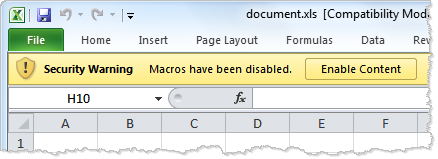How Malicious Code Can Run in Microsoft Office Documents
Microsoft Office documents can execute malicious code through VBA macros (requiring social engineering to enable), exploit payloads targeting Office vulnerabilities, embedded Flash objects, or JavaScript via ScriptBridge ActiveX controls. Attackers often use these techniques in targeted attacks.
One of the most effective methods of compromising computer security, especially as part of a targeted attack, involves emailing the victim a malicious Microsoft Office document. Even though the notion of a document originally involved non-executable data, attackers found ways to cause Microsoft Office to execute code embedded within the document. Below are 4 of the most popular techniques used to accomplish this.
VBA Macros
Support for executing code that’s embedded as a VBA macro is built into Microsoft Office. Once the victim opens the document and allows macros to run, this code can run arbitrary commands on the user’s system, including those that launch programs and interact over the network. The penetration testing tool Metasploit makes it relatively straightforward to generate payload that attackers could embed in an Office file as a VBA macro.
Such macros can be included in “legacy” binary formats (.doc, .xls., .ppt) and in modern XML-formatted documents supported by Microsoft Office 2007 and higher. In either case, Office will present the user with a security warning, stating that macros have been disabled and offering to “enable content.” Social engineering techniques can persuade the victim to click the button that will allow the embedded macro to run and infect the system.

Payload of a Microsoft Office Exploit
Another way to execute malicious code as part of an Office document involves exploiting vulnerabilities in a Microsoft Office application. The exploit is designed to trick the targeted application into executing the attacker’s payload, which is usually concealed within the Office document as shellcode. In this case, Microsoft Office has to be exploited to execute the attacker’s code. This is in contrast to the previous scenario, where the attacker takes advantage of macros, supported by Microsoft Office as a feature.
For instance the CVE-2012-0141 vulnerability could allow the attacker to craft a malicious Excel file to include an exploit that would “take complete control of an affected system.”
Embedded Flash Program
Embedding a Flash program inside an Office document provides attackers yet another way to run malicious code on the victim’s system. In this case, the code within the Flash object run as soon as the victim opens the document without any warnings and without relying on exploits. This code is till subject to security restrictions imposed by Flash Player, so to perform escalated actions the code would need to exploit a vulnerability in Flash Player.
One example of this attack has been described by Mila on the Contagio blog. The malicious Word document “DOC Iran’s Oil and Nuclear Situation.doc” was sent to a victim as part of a targeted attack. The document contained a Flash object, as seen below. (See steps to manually embed a Flash object in an Office document.)

Attackers can embed Flash objects in Office documents using automated tools. manual steps to do this the Flash object instructed Flash Player to download and play an MP4 file that was designed to exploit the CVE-2012-0754 vulnerability in Flash Player. This allowed the attacker to infect the victim’s system with a malicious Windows executable (trojan).
Embedded JavaScript
Another way to automatically execute code then the victim opens a Microsoft Office document involves embedding the ScriptBridge ActiveX control in the file. This control allows the attacker to embed and execute JavaScript, as was the case with the malicious “World Uyghur Congress Invitation.doc” file I obtained from the Contagio blog. This file used the “Microsoft Scriptlet Component”, implemented as the ScriptBridge ActiveX control to execute the embedded JavaScript code.

This Word file used ScriptBridge to execute embedded JavaScript code, which downloaded a malicious Flash file by from the specified URL. Microsoft Office automatically invokes embedded ActiveX controls that are marked Safe-For-Initialization, which is the case with ScriptBridge. (I’d love to better understand how ScriptBridge is being used to run JavaScript, so if you have more details, please let me know.)

In the case of this Word document, the downloaded Flash file was crafted to exploit the CVE-2012-0779 vulnerability in Flash player.
These are some of the techniques that intruders have used to execute code in Microsoft Office documents to compromise the system. The attacker could directly take advantage of a vulnerability in the targeted Office application. In other cases, the attacker uses functionality provided by Microsoft Office to either trick the user into allowing the malicious code to run (VBA macros) or to use a weakness in Office settings to run code that exploits vulnerabilities in other applications (Flash Player).
Related articles: